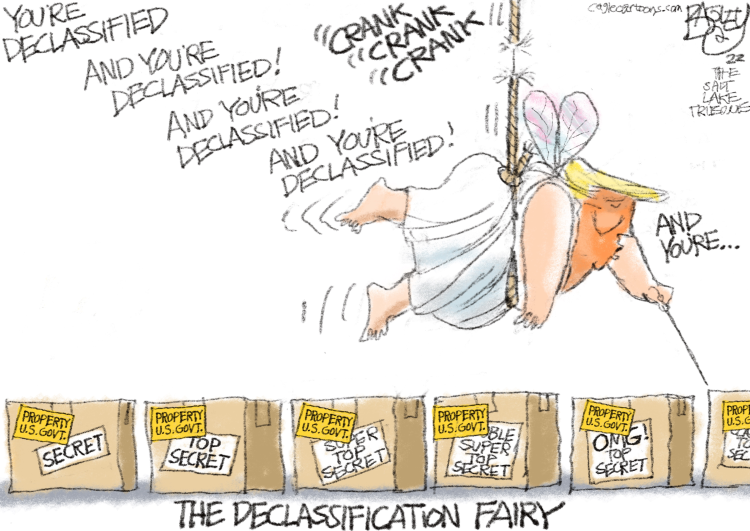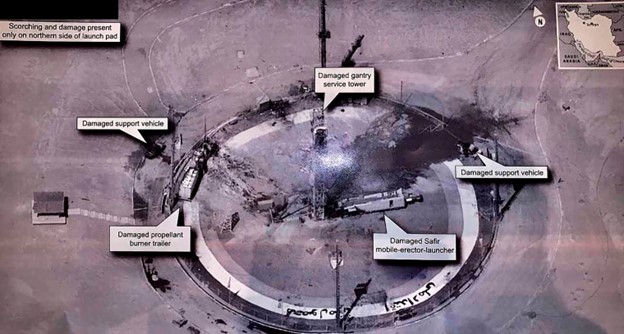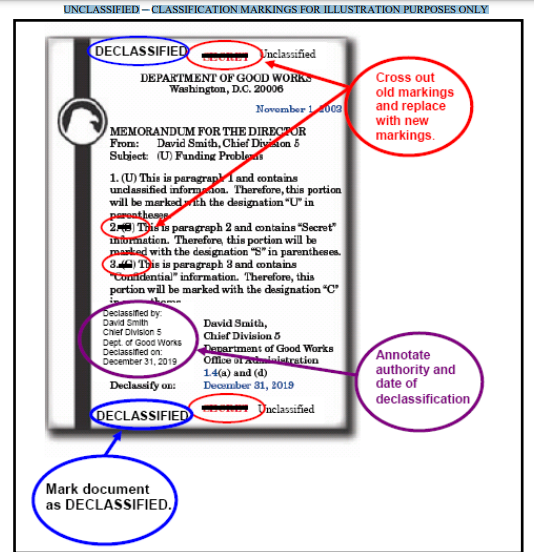
UPDATE II:
Here is a great one by Pat Bagley, Cagle Cartoons, that would have saved me a whole lot of writing:

UPDATE I:
An NBC News piece confirms a point in the article below regarding Trump’s lack of interest, indolence, when it came to reading even short written summaries of his regular intelligence briefings. CIA personnel had to load the briefings with “striking images, pared-down charts and slick graphics” to grab Trump’s “fleeting interest.”
In addition, the piece illustrates Trump’s total lack of national security awareness when he tweeted — against the advice of his national security experts — a highly classified image taken by one of America’s premier secret spy satellites of an Iranian missile launch site (below), giving “U.S. adversaries keen insights into the U.S. capabilities to spy from above.”

“Look, I’m the president, I can declassify anything,” Trump said according to an official.
Read more HERE
Original Post:
In the wake of the Justice Department’s search and seizure of misappropriated government material — including classified national security documents — at Trump’s Mar-a-Lago residence, many experts have focused on our nation’s classification system.
An article by Jeffrey Fields, does an excellent job of describing the purpose of the classification system, classification levels, classification (and declassification) authorities.
There are numerous comprehensive manuals, regulations, instructions and orders detailing such systems and procedures, including methods for storing, transporting, transmitting, safeguarding our nation’s secrets.
At the Department of Defense (DoD) level and at other government departments, agencies and branches there are also crystal-clear rules and procedures as to who can declassify or downgrade classified information and how it should be done.
For example, DoD Manual 5200.01, Volume 1, devotes 19 pages to describe the policy, authority and procedures for declassifying or downgrading classified information.
In addition, DoD Manual 5200.01, Volume 2, has three pages specifying how material that has been declassified or downgraded shall be marked, indicating among other the authority for and date of declassification (below).

The focus in the media has been on whether Trump — who on his way out of the White House had dozens of boxes filled with government documents, including classified ones, to take to Mar-a-Lago — had the (ultimate) authority to declassify such documents.
His supporters claim, without any foundation or scruples, that Trump, “in order to prepare for work the next day, often took documents including classified documents from the Oval Office to the residence” and that – presumably because of such devotion to duty — he “had a standing order that documents removed from the Oval Office and taken into the residence were deemed to be declassified the moment he removed them.” The preposterous “magic wand” theory.
John Bolton, who served as Trump’s national security adviser over 17 months, calls the claim of a standing order “almost certainly a lie.”
A couple of observations are in order here:
Trump’s staff could not get him to read the daily intelligence reports so critical to do the nation’s security. Why would Trump take documents to the residence, except, perhaps, to tear them up and flush them down the toilet?
Even more absurd: On Wednesday, January 20, 2021, there would not be a “next day” for Trump to “prepare for work.” Why would he take a truckload of documents – including many containing the nation’s highest secrets — to his club at Mar-a- Lago?
In his article, professor Fields notes that procedures for declassification of materials “are complicated.” By “linkage” Fields is referring to Executive Order 12356 , “National Security information.”
However, regardless of bureaucratic complexity and whether the president has unlimited authority to declassify, there are still declassification procedures that must be followed in many cases.
For example, Section 3.4(a) of Executive Order 12356, Mandatory Review for Declassification, albeit in a “complicated way,” exempts only certain documents considered for declassification from “review for declassification by the originating agency.”
Charlie Savage at the New York Times calls the question of whether a president can secretly declassify information without leaving a record or telling anyone “borderline incoherent.”
“If there is no directive memorializing a decision to declassify information and conveying it to the rest of the government,” he says, “the action would essentially have no consequence, as departments and agencies would continue to consider that information classified and so would continue to restrict access to documents containing it.”
Trump himself has acknowledged that there are procedures for reviewing and declassifying information. He followed such procedures on January 19, 2021, when he directed the declassification and release of “certain materials related to the FBI’s Crossfire Hurricane investigation.” (The “Russia, Russia” investigation)
Executive Order 13526 – “Classified National Security Information,” signed by President Obama in December 2009, states in its preamble:
Our democratic principles require that the American people be informed of the activities of their Government…Nevertheless, throughout our history, the national defense has required that certain information be maintained in confidence in order to protect our citizens, our democratic institutions, our homeland security, and our interactions with foreign nations. Protecting information critical to our Nation’s security and demonstrating our commitment to open Government through accurate and accountable application of classification standards and routine, secure, and effective declassification are equally important priorities.
A reasonable person perusing through that executive order and through the many other national security orders and regulations must admit that the former president has, at the very least, recklessly and knowingly betrayed the trust the American people placed in him to faithfully protect the nation’s secrets.
On a personal note:
As a young Air Force officer, I was responsible for the safekeeping of cryptologic communications keys and other classified documents.
I took my responsibilities so serious that I did not even write down the combinations to the safes in which the documents were stored,
To this date, I have nightmares about forgetting the combinations or, worse, about misplacing a classified document.
It pains me deeply to realize that the former commander in chief has absolutely no concern or remorse for taking, mishandling and endangering documents “the unauthorized disclosure of which reasonably could be expected to cause exceptionally grave damage to the national security.”
















